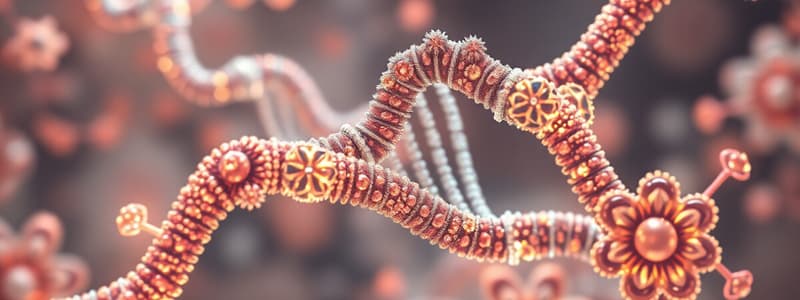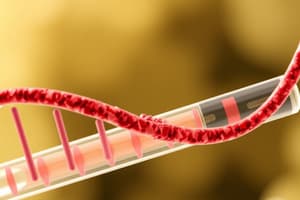Podcast
Questions and Answers
What is the primary purpose of Polymerase Chain Reaction (PCR)?
What is the primary purpose of Polymerase Chain Reaction (PCR)?
- To analyze RNA sequences
- To repair damaged DNA
- To amplify DNA samples (correct)
- To sequence genetic material
Which of the following components is NOT needed for the PCR process?
Which of the following components is NOT needed for the PCR process?
- Cellular environment (correct)
- Primers
- Buffer solution
- DNA portion to be copied
How does the process of PCR compare to using a physical copy machine?
How does the process of PCR compare to using a physical copy machine?
- PCR requires more thoughtful setup and time-consuming adjustments.
- PCR does not require physical materials like paper. (correct)
- Both processes require multiple operators to function efficiently.
- Both processes are simple and do not require specific components.
What role do primers play in the PCR process?
What role do primers play in the PCR process?
Why is PCR considered a revolutionary technique in biotechnology?
Why is PCR considered a revolutionary technique in biotechnology?
What happens to the DNA during the PCR process?
What happens to the DNA during the PCR process?
Which of the following statements about PCR is true?
Which of the following statements about PCR is true?
What is a key limitation of PCR?
What is a key limitation of PCR?
During what phase does the actual replication of DNA occur in PCR?
During what phase does the actual replication of DNA occur in PCR?
What type of technology does PCR resemble in functionality?
What type of technology does PCR resemble in functionality?
What is the primary role of primers in PCR?
What is the primary role of primers in PCR?
What is the function of Taq polymerase in PCR?
What is the function of Taq polymerase in PCR?
During which step of PCR does the temperature increase to separate the two DNA strands?
During which step of PCR does the temperature increase to separate the two DNA strands?
What does the annealing step in PCR involve?
What does the annealing step in PCR involve?
How does PCR contribute to DNA fingerprinting?
How does PCR contribute to DNA fingerprinting?
In the context of a COVID-19 test, what is the role of reverse transcriptase?
In the context of a COVID-19 test, what is the role of reverse transcriptase?
What is the expected outcome after one complete cycle of PCR on a single double-stranded DNA molecule?
What is the expected outcome after one complete cycle of PCR on a single double-stranded DNA molecule?
Why is Taq polymerase preferred for PCR?
Why is Taq polymerase preferred for PCR?
What happens if the primers do not bind during the PCR process?
What happens if the primers do not bind during the PCR process?
What is the significance of using fluorescent probes in PCR tests?
What is the significance of using fluorescent probes in PCR tests?
Polymerase Chain Reaction (PCR) can only occur inside a living cell.
Polymerase Chain Reaction (PCR) can only occur inside a living cell.
PCR is often compared to a copy machine because it amplifies a specific portion of DNA.
PCR is often compared to a copy machine because it amplifies a specific portion of DNA.
Primers are unnecessary for the amplification of DNA in PCR.
Primers are unnecessary for the amplification of DNA in PCR.
The process of PCR involves repeating cycles to produce more DNA.
The process of PCR involves repeating cycles to produce more DNA.
A buffer is among the necessary components to perform PCR.
A buffer is among the necessary components to perform PCR.
PCR requires the entire DNA molecule to be replicated at once.
PCR requires the entire DNA molecule to be replicated at once.
Using PCR, one can amplify a small sample of DNA into a large quantity.
Using PCR, one can amplify a small sample of DNA into a large quantity.
PCR operates effectively only at room temperature.
PCR operates effectively only at room temperature.
The technology used in PCR is limited to only academic research settings.
The technology used in PCR is limited to only academic research settings.
PCR is a technique that has no influence on modern biotechnology practices.
PCR is a technique that has no influence on modern biotechnology practices.
The process of PCR includes three major steps: denaturation, annealing, and DNA synthesis.
The process of PCR includes three major steps: denaturation, annealing, and DNA synthesis.
Taq polymerase is derived from a type of bacteria that can survive at low temperatures.
Taq polymerase is derived from a type of bacteria that can survive at low temperatures.
In the annealing step of PCR, the temperature decreases to allow primers to bind to the DNA strands.
In the annealing step of PCR, the temperature decreases to allow primers to bind to the DNA strands.
The temperature during DNA synthesis in PCR is cooler than in the annealing step.
The temperature during DNA synthesis in PCR is cooler than in the annealing step.
PCR can be used for applications such as DNA fingerprinting and disease diagnosis.
PCR can be used for applications such as DNA fingerprinting and disease diagnosis.
Reverse transcriptase is used in PCR to convert DNA into RNA.
Reverse transcriptase is used in PCR to convert DNA into RNA.
After one complete cycle of PCR, the total number of double-stranded DNA molecules doubles.
After one complete cycle of PCR, the total number of double-stranded DNA molecules doubles.
Specific fluorescent probes are not needed for PCR testing if the viral genetic material is present.
Specific fluorescent probes are not needed for PCR testing if the viral genetic material is present.
Denaturation in PCR involves the use of heat to separate the DNA strands.
Denaturation in PCR involves the use of heat to separate the DNA strands.
The final product of PCR is always a single strand of DNA.
The final product of PCR is always a single strand of DNA.
Flashcards
PCR
PCR
Polymerase Chain Reaction is a laboratory technique used to amplify a specific DNA sequence.
Amplifying DNA
Amplifying DNA
Increasing the number of copies of a specific DNA segment.
DNA
DNA
Deoxyribonucleic Acid, a molecule carrying genetic instructions in living organisms.
Test tube
Test tube
Signup and view all the flashcards
Primers
Primers
Signup and view all the flashcards
DNA replication
DNA replication
Signup and view all the flashcards
Buffer
Buffer
Signup and view all the flashcards
Specific DNA Segment
Specific DNA Segment
Signup and view all the flashcards
Copy Machine
Copy Machine
Signup and view all the flashcards
Biotechnology
Biotechnology
Signup and view all the flashcards
DNA polymerase
DNA polymerase
Signup and view all the flashcards
Taq polymerase
Taq polymerase
Signup and view all the flashcards
Denaturation (PCR)
Denaturation (PCR)
Signup and view all the flashcards
Annealing (PCR)
Annealing (PCR)
Signup and view all the flashcards
DNA synthesis (PCR)
DNA synthesis (PCR)
Signup and view all the flashcards
DNA nucleotides
DNA nucleotides
Signup and view all the flashcards
Real-time reverse transcription PCR (rRT-PCR)
Real-time reverse transcription PCR (rRT-PCR)
Signup and view all the flashcards
cDNA (complementary DNA)
cDNA (complementary DNA)
Signup and view all the flashcards
What is PCR?
What is PCR?
Signup and view all the flashcards
Why use PCR?
Why use PCR?
Signup and view all the flashcards
What's needed for PCR?
What's needed for PCR?
Signup and view all the flashcards
What is the role of primers in PCR?
What is the role of primers in PCR?
Signup and view all the flashcards
What are the three main steps of PCR?
What are the three main steps of PCR?
Signup and view all the flashcards
What is denaturation in PCR?
What is denaturation in PCR?
Signup and view all the flashcards
What is annealing in PCR?
What is annealing in PCR?
Signup and view all the flashcards
What is extension in PCR?
What is extension in PCR?
Signup and view all the flashcards
What is the significance of Taq polymerase in PCR?
What is the significance of Taq polymerase in PCR?
Signup and view all the flashcards
How does PCR help in real-world applications?
How does PCR help in real-world applications?
Signup and view all the flashcards
Why is PCR useful?
Why is PCR useful?
Signup and view all the flashcards
What is Taq polymerase?
What is Taq polymerase?
Signup and view all the flashcards
What is DNA synthesis in PCR?
What is DNA synthesis in PCR?
Signup and view all the flashcards
What is reverse transcription?
What is reverse transcription?
Signup and view all the flashcards
What is rRT-PCR test?
What is rRT-PCR test?
Signup and view all the flashcards
What is cDNA?
What is cDNA?
Signup and view all the flashcards
Study Notes
Polymerase Chain Reaction (PCR)
- PCR is a technique to amplify (copy) DNA
- It's like a DNA copy machine, allowing analysis of tiny DNA samples
- PCR works in test tubes, not cells
How PCR Works
- Needs:
- Target DNA segment
- Buffer solution
- Primers (guide DNA polymerase)
- DNA polymerase (building enzyme, often heat-resistant Taq polymerase)
- DNA nucleotides (building blocks)
- Three main steps:
- Denaturation: Heat separates DNA strands
- Annealing: Cool to allow primers to bind to target DNA segment
- DNA Synthesis: DNA polymerase uses nucleotides to build new strands, doubling the DNA amount with each cycle
Why PCR?
- Useful for technologies requiring many DNA copies, like:
- DNA fingerprinting (crime scene investigations)
- Disease diagnosis (e.g., COVID-19 rRT-PCR tests)
Types of PCR Tests
- rRT-PCR (real-time reverse transcription PCR): used for RNA viruses like SARS-CoV-2
- Converts RNA to DNA (cDNA) using reverse transcriptase.
- Then, regular PCR steps are applied to amplify the cDNA copies
Additional DNA Enzymes
- Helicase: Unwinds DNA (heat does this too, as seen in PCR)
- Ligase: Joins DNA strands
- DNA Polymerases: Create complementary DNA strands
- RNA Polymerases: Create complementary RNA strands
- Reverse Transcriptase: Creates DNA from RNA (unique, found in some viruses)
- Restriction Endonucleases: Cut DNA at specific points (DNA scissors)
Studying That Suits You
Use AI to generate personalized quizzes and flashcards to suit your learning preferences.




